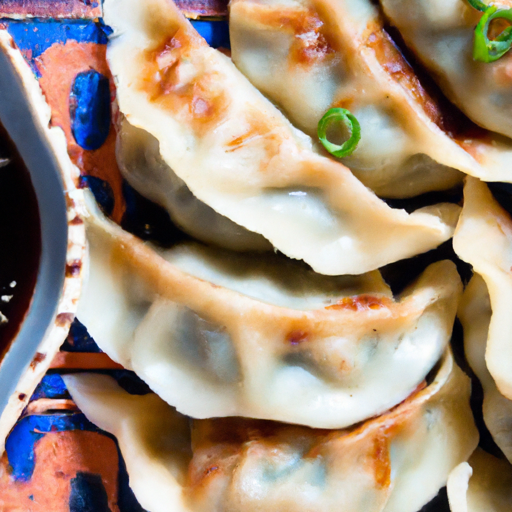Chinese Dumplings: A Delightful Delicacy
If there’s one Chinese dish that has captured the hearts and taste buds of people all around the world, it’s undoubtedly the humble dumpling. These little pockets of goodness are not just a delicious treat; they also offer a fascinating glimpse into Chinese culinary history and culture. In this blog post, we’ll explore the mouthwatering taste, versatile uses, nutritional value, and intriguing facts surrounding Chinese dumplings.
Taste that Leaves You Craving More
Chinese dumplings, also known as Jiaozi, are filled with a delectable mixture of ingredients that create a burst of flavor in every bite. The filling can vary, but it typically consists of finely chopped vegetables such as cabbage, mushrooms, and carrots, combined with ground meat like pork or chicken. Seasoned with soy sauce, ginger, garlic, and a hint of sesame oil, the filling becomes incredibly savory and fragrant.
The magic, however, lies not just in the filling, but also in the texture of the dumpling itself. The soft and chewy dough, made from a simple mixture of flour and water, encases the flavorful filling, providing a delightful contrast in every mouthful. Whether pan-fried, steamed, or boiled, Chinese dumplings always deliver a satisfying combination of crispiness, tenderness, and juiciness.
Versatility in Cooking
Chinese dumplings are incredibly versatile and can be enjoyed in various ways. They are a staple during Chinese New Year celebrations, as they symbolize wealth and good fortune. Families gather to make and share dumplings, which creates a sense of togetherness and unity.
These scrumptious delights are not limited to special occasions though. They can be enjoyed as a quick street food snack, a hearty appetizer, or even a main course. Pan-fried dumplings, also known as potstickers, have a delightfully crispy bottom while maintaining a juicy filling. Steamed dumplings, on the other hand, showcase the delicate flavors of the ingredients. Boiled dumplings offer a comforting, soup-like experience. The choice is yours, and each method offers a unique culinary adventure.
Nutritional Goodness in Every Bite
Beyond their appetizing taste and culinary versatility, Chinese dumplings also pack a nutritious punch. With a balanced combination of proteins, fibers, and vegetables, they offer a wholesome eating experience. The use of lean meats such as chicken or pork provides a good source of protein, while the vegetables add essential vitamins and minerals. Plus, the use of minimal oil in cooking ensures a healthier option, perfect for those conscious of their diet.
A Brief Dip into History and Fascinating Facts
Chinese dumplings have a long and rich history that dates back to ancient times. Legend has it that a Chinese doctor named Zhang Zhongjing created the first dumplings during the Han Dynasty in an effort to fight the biting cold of winter. He filled dough wrappers with nutrient-rich ingredients, and by boiling them, he created a warming and nourishing meal.
Dumplings are deeply rooted in Chinese culture and carry significant symbolism. The shape of a dumpling is said to resemble ancient Chinese currency – the ingot. It’s no wonder that dumplings are often consumed during festivities, as they represent wealth and prosperity. Furthermore, the act of making dumplings together has become a traditional and joyous family activity, fostering intergenerational bonds and cherished memories.
Conclusion
Chinese dumplings, with their tantalizing flavors, versatile preparation methods, nutritional value, and rich cultural heritage, have become a beloved culinary treasure worldwide. Whether you enjoy them as a quick snack, a mouthwatering appetizer, or a wholesome main course, Chinese dumplings never fail to delight the taste buds. So next time you’re craving a truly satisfying culinary experience, consider trying your hand at making these delightful, flavor-packed dumplings.
Origin of Chinese Dumplings:
- Chinese dumplings, also known as Jiaozi, date back over 1,800 years and have a rich history in Chinese cuisine.
- Jiaozi is believed to have been invented in the era of the Eastern Han Dynasty (AD 25-220) by a physician named Zhang Zhongjing.
- The shape of the dumplings is said to resemble ancient Chinese money, and it is believed that eating dumplings during the Chinese New Year brings prosperity and wealth.
Common Uses of Chinese Dumplings:
- Chinese dumplings are commonly consumed during holidays, festivals, family gatherings, and special occasions, especially during the Chinese New Year.
- They can be boiled, steamed, pan-fried, or deep-fried depending on the regional preference.
- Dumplings can be filled with various ingredients, including minced meat (most commonly pork), vegetables, seafood, and sometimes fungi or grains.
Nutritional Benefits of Chinese Dumplings:
- Chinese dumplings can be a good source of protein, depending on the filling used.
- The vegetables used in dumpling fillings, such as cabbage, chives, and mushrooms, provide essential vitamins and minerals.
- Dumplings can be a rich source of carbohydrates, especially when made with wheat or rice flour wrappers.
Unique Properties and Historical Significance of Chinese Dumplings:
- Dumplings are known for their unique shape and the artistry involved in making them. The pleats or folds on the dumplings can vary in numbers and patterns, distinguishing regional styles.
- Dumplings have significance beyond just being a delicious food. They are often seen as a representation of family unity and symbolize good luck and prosperity.
- In Northern China, during the winter solstice, families traditionally make jiaozi together, believing that the more dumplings they make, the better their harvest will be in the coming year. This ritual is called “making dumplings to welcome the kitchen god.”
These facts provide an overview of the origin, common uses, nutritional benefits, and unique properties of Chinese dumplings.




Use the share button below if you liked it.
It makes me smile, when I see it.